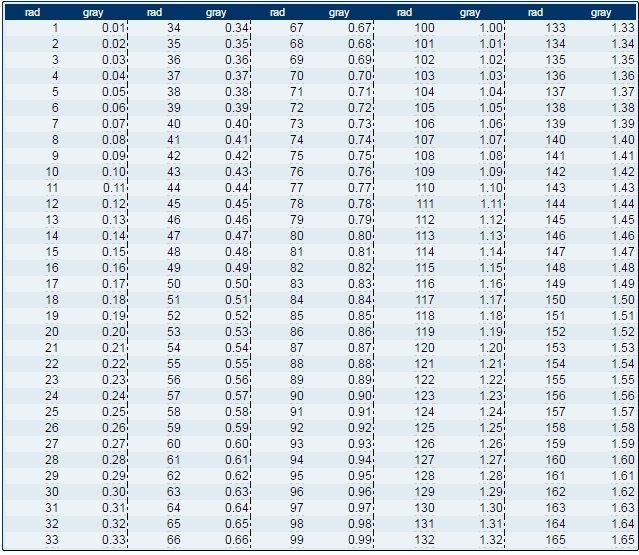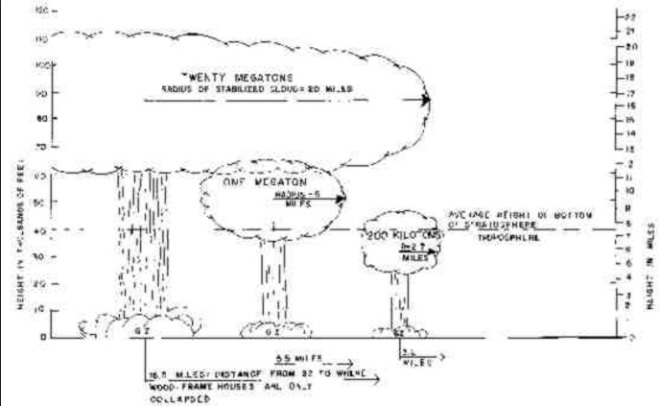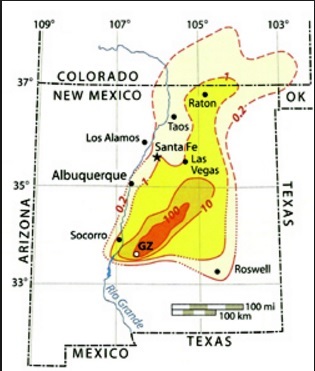
In the last post we discussed personal protective equipment for the nuclear environment. This post concerns having a way to communicate a nuclear explosion in your area via HAM or whatever other commo device you might have available. This is modeled after the the military’s NBC reporting format, but is different and more specific just for a nuclear situation. The reason I set it up that way is simple. If this info makes it’s way back to the military or government through civilian channels, it will be easier for them to convert it into a report to send higher up the chain without having to totally reconstruct or interpret the reports.

OK, so let’s go through the “Nuke-O-Spot 1 Report” step by step. If the right column is blacked out, it does not get filled in on that specific report. NOTE: If a letter is skipped, it was for the chem or bio part of the original military report template, and doesn’t relate to the nuclear section. B- Where are you? Find out on a map or GPS what your location is and make sure you list the type of coords you’re using. C- Using your compass, what direction is the blast in? D- Usually, this will be as follows “DDMMMYY, and 24 hour time format with your time zone (that’s important) listed after the number. G- Self explanatory. H- Was it up in the sky, or close to the ground when it went off? J- Count “one thousand one, one thousand two…..” and take that times 330 to give you the distance in meters. You only need to put the time between the flash and bang in this block though. L- Use the finger scale below as your measurement guide in Mils., and take the width measurement 5 minutes after detonation. This is an approximation. M- A fist held straight away from the body with arm extended is approximately 150 Mils,. take the height measurement 1 minute after detonation. Just measure the height by how many stacked fists it is. This is an approximation. O- If you can’t take the height measurement at H+1 (or you take another measurement) reference the date/time of blast (H+0), and the height in mils or degree. Example at H+15 the height is 4 fists (approx. 600 mils) high. Q- When taking a radiation reading, put the location coordinates, or the name of the location (town, major intersection, etc.). R- Dose rate of the radiation in Rads or Gray measurements. See the chart below. S- The date and time group that the reading was taken.



The “Nuke-O-Spot 2 Report” is basically a compilation of multiple N-O-S 1 Reports at an “Info Hub”. Here’s how it works. A- This number is assigned by the group compiling the info D- Same as N-O-S 1. F- The Info Hub will use the multiple N-O-S 1 reports to triangulate the location of the detonation. G- Same as N-O-S 1 reports. H- Same as N-O-S 1 reports. N- If the Info Hub has the capability to determine yield by using the cloud height and width information. P- Info Hub uses weather/winds aloft reports to determine the direction of fallout. Z- The Info Hub will use the weather/winds aloft report to determine and report the speed of the fallout cloud.


HOW IT WORKS
There are enough HAM operators (AMRRON maybe) out there to be able to pass this info on to those that can disseminate it to those who need it most and can determine countermeasures. My suggestion is to find a HAM operator in your region that was an NBC specialist in the military, and use him or her as your Info Hub to feed N-O-S 1 reports to. There are plenty of NBC FM’s out there to figure a good bit of this out for yourself. Your group should understand and be able to apply this info for the group’s protection. NOTE: Winds aloft can change directions about every 2,000 feet, and this is why a fallout pattern does not always have a circular or oval shape. Keep this in mind if you are trying to predict the fallout pattern.

I while back, a friend asked me to put this format out. I have finally gotten around to it, because I think it might be needed in the near future, considering the direction certain national and international players are leaning. Hopefully it won’t be needed, but you know what they say, “Better to have and not need, than to need and not have.

Even “Vault Boy” from the game “Fallout 4” knows how to use the “Rule of Thumb”. If the mushroom cloud is wider than the thumb, seek cover immediately. If not, you have a little time.
JCD

Man, this is a blast from the past. Amazing how much I’ve forgotten over the years. Going to have to re-read this a few times to try to get everything to sink in again.
LikeLike
Yeah, same here.
Graduated NBC School at Camp Geiger NC in Nov 74, a lot of it has stayed with me, other things forgotten. Used PRC-25’s and KY-38 scramblers overseas, remember how to set keys but the rest of the HAM stuff never interested me an iota. Don’t even own a cell phone.
I prefer KISS and no footprint.
LikeLike
Yah buuut…. I’m no expert, obviously!, but how would the resultant EMP of a nuclear detonation affect SW communications? Asking for a friend….
LikeLike
That’s why we have cups with string……
LikeLike